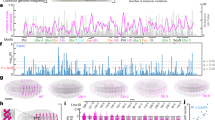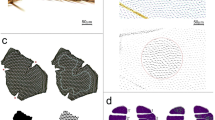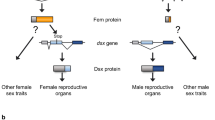Abstract
Morphological alterations have been shown to occur in Drosophila melanogaster when function of Hsp90 (heat shock 90-kDa protein 1α, encoded by Hsp83) is compromised during development1. Genetic selection maintains the altered phenotypes in subsequent generations1. Recent experiments have shown, however, that phenotypic variation still occurs in nearly isogenic recombinant inbred strains of Arabidopsis thaliana2. Using a sensitized isogenic D. melanogaster strain, iso-KrIf-1, we confirm this finding and present evidence supporting an epigenetic mechanism for Hsp90's capacitor function, whereby reduced activity of Hsp90 induces a heritably altered chromatin state. The altered chromatin state is evidenced by ectopic expression of the morphogen wingless in eye imaginal discs and a corresponding abnormal eye phenotype, both of which are epigenetically heritable in subsequent generations, even when function of Hsp90 is restored. Mutations in nine different genes of the trithorax group that encode chromatin-remodeling proteins also induce the abnormal phenotype. These findings suggest that Hsp90 acts as a capacitor for morphological evolution through epigenetic and genetic mechanisms.
This is a preview of subscription content, access via your institution
Access options
Subscribe to this journal
Receive 12 print issues and online access
$209.00 per year
only $17.42 per issue
Buy this article
- Purchase on Springer Link
- Instant access to full article PDF
Prices may be subject to local taxes which are calculated during checkout




Similar content being viewed by others
References
Rutherford, S.L. & Lindquist, S. Hsp90 as a capacitor for morphological evolution. Nature 396, 336–342 (1998).
Queitsch, C., Sangster, T.A. & Lindquist, S. Hsp90 as a capacitor of phenotypic variation. Nature 417, 618–624 (2002).
Jackle, H. et al. Molecular analysis of Kruppel, a segmentation gene of Drosophila melanogaster. Cold Spring Harb. Symp. Quant. Biol. 50, 465–473 (1985).
Carrera, P. et al. A modifier screen in the eye reveals control genes for Kruppel activity in the Drosophila embryo. Proc. Natl. Acad. Sci. USA 95, 10779–10784 (1998).
Abrell, S., Carrera, P. & Jackle, H. A modifier screen of ectopic Kruppel activity identifies autosomal Drosophila chromosomal sites and genes required for normal eye development. Chromosoma 109, 334–342 (2000).
Kennison, J.A. & Tamkun, J.W. Dosage-dependent modifiers of polycomb and antennapedia mutations in Drosophila. Proc. Natl. Acad. Sci. USA 85, 8136–8140 (1988).
Paro, R., Strutt, H. & Cavalli, G. Heritable chromatin states induced by the Polycomb and trithorax group genes. Novartis Found. Symp. 214, 51–61 (1998).
Dickson, B.J., van der Straten, A., Dominguez, M. & Hafen, E. Mutations modulating Raf signaling in Drosophila eye development. Genetics 142, 163–171 (1996).
Mollaaghababa, R. et al. Mutations in Drosophila heat shock cognate 4 are enhancers of Polycomb. Proc. Natl. Acad. Sci. USA 98, 3958–3963 (2001).
Lecuit, T. & Cohen, S.M. Proximal–distal axis formation in the Drosophila leg. Nature 388, 139–145 (1997).
Gibson, M., Lehman, D. & Schubiger, G. Lumenal transmission of decapentaplegic in Drosophila imaginal discs. Dev. Cell 3, 451 (2002).
Lecuit, T. & Cohen, S.M. Dpp receptor levels contribute to shaping the Dpp morphogen gradient in the Drosophila wing imaginal disc. Development 125, 4901–4907 (1998).
Steffan, J.S. et al. Histone deacetylase inhibitors arrest polyglutamine-dependent neurodegeneration in Drosophila. Nature 413, 739–743 (2001).
Kang, H.L., Benzer, S. & Min, K.T. Life extension in Drosophila by feeding a drug. Proc. Natl. Acad. Sci. USA 99, 838–843 (2002).
Adams, M.D. et al. The genome sequence of Drosophila melanogaster. Science 287, 2185–2195 (2000).
Waddington, C.H. Canalization of development and the inheritance of acquired characters. Nature 150, 563–565 (1942).
Waddington, C.H. Genetic assimilation of an acquired character. Evolution 7, 118–126 (1953).
Kohler, C. & Grossniklaus, U. Epigenetics: the flowers that come in from the cold. Curr. Biol. 12, R129–R131 (2002).
Bender, J. Plant epigenetics. Curr. Biol. 12, R412–R414 (2002).
Gould, S.J. & Eldredge, N. Punctuated equilibrium comes of age. Nature 366, 223–227 (1993).
Goldstein, L.S.B. Drosophila melanogaster: Practical Uses in Cell and Molecular Biology (Academic Press, San Diego, California, 1994).
Ashburner, M. Drosophila: A Laboratory Handbook (Cold Spring Harbor Laboratory Press, Cold Spring Harbor, 1989).
Acknowledgements
We thank J. Kennison for providing fly stocks, G. Schubiger for recognizing that the ectopic outgrowths had triplicate vibrissae, T. Townes for suggesting the trichostatin A and sodium butyrate experiments and J. Horabin, S. Wilson and M. Bertram for reviewing the manuscript. This work was supported by Basil O'Connor Starter Scholar Research Awards to X.L. and D.M.R., a grant from the American Cancer Society to X.L. and grants from the US National Institutes of Health to X.L. and D.M.R.
Author information
Authors and Affiliations
Corresponding author
Ethics declarations
Competing interests
The authors declare no competing financial interests.
Supplementary information
Rights and permissions
About this article
Cite this article
Sollars, V., Lu, X., Xiao, L. et al. Evidence for an epigenetic mechanism by which Hsp90 acts as a capacitor for morphological evolution. Nat Genet 33, 70–74 (2003). https://doi.org/10.1038/ng1067
Received:
Accepted:
Published:
Issue Date:
DOI: https://doi.org/10.1038/ng1067
This article is cited by
-
Loss of Nexmif results in the expression of phenotypic variability and loss of genomic integrity
Scientific Reports (2022)
-
Heat-shock proteins: chaperoning DNA repair
Oncogene (2020)
-
Mechanism of evolution by genetic assimilation
Biophysical Reviews (2018)
-
Low genetic but high morphological variation over more than 1000 km coastline refutes omnipresence of cryptic diversity in marine nematodes
BMC Evolutionary Biology (2017)
-
The evolutionary capacitor HSP90 buffers the regulatory effects of mammalian endogenous retroviruses
Nature Structural & Molecular Biology (2017)



